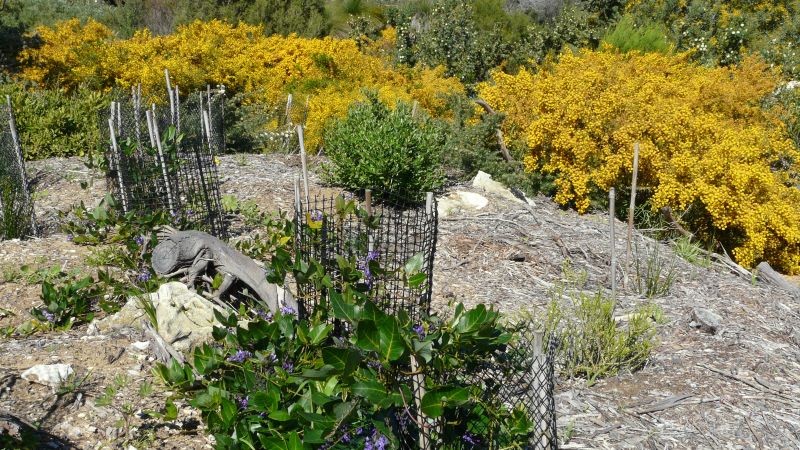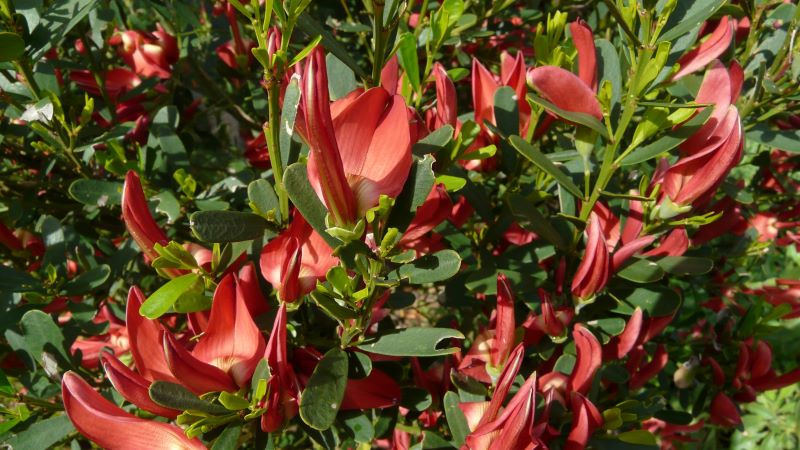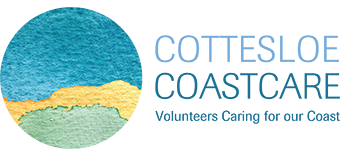Cottesloe Native Garden
Cottesloe Native Garden is just next door to Seaview Kindergarten on Broome Street.
This special place has been a project area for Cottesloe Coastcare since 2006 and is the only site in Cottesloe with such richness of remnant local native plant species. The limestone outcrops provide a special habitat to many plant species which grow nowhere else in our town.
In 1983 the naturalist Robert Powell identified 37 local native plant species at Cottesloe Native Garden. In 2006 30 of these local plant species remained despite massive weed infestation. Of these eight species had less than six plants remaining.
Some of the special plant species that are only found at this one place in Cottesloe are Yellow Leschenaultia (Lechenaultia linariodes), Coastal Sedge (Lepidosperma calcicola), and Yellow Autumn Lily (Tricoryne tenella). In 2017 we found Pink Fairy Orchids (Caladenia latiflolia) flowering. This was the first time we had seen them in Cottesloe. Wonderful old pre-European Grass Trees (Xanthorrhoea preissii) are magnets for insects and birds.
You can see a list of the plants that occur at this site here.
With its dense and prickly bushes this site is a safe haven for many small birds including White-cheeked Honeyeaters, Singing Honeyeaters, Brown Honeyeaters, White-browed Scrubwrens and Purple-backed Fairy-wrens. White tailed Black Cockatoos are sometimes seen in the Rottnest pines, Sheoaks, Banksias or Parrot Bushes searching for seeds.
Forrest Park?
Before any golf course was here the whole of the land from Broome Street to Marine Parade was an A class reserve known as Forrest Park.
Mary and Eddie Edwards were the first to care for this patch of remnant vegetation. They weeded and planted with a small group of volunteers in the early 1980’s along with the children of Seaview Kindergarten. You can read more about Mary here.

2014 Alex mapping tea tree, 75% of the area was covered in tea tree.

2015 Tea tree removed and mulched.

2015 planting started in winter.

2017 same site 2 years later.

2017 many local species thriving.

Cockies tongues (Templetonia retusa) grows well on this limestone ridge.
What we are protecting
Yellow Admiral Butterfly

A migratory butterfly, the Yellow Admiral lays its eggs on Native Pellitory (Parietaria debilis). Pellitory is a small annual herb that is spreading here underneath local tea trees and other shrubs in dappled shade. The Yellow Admirals visit to lay their eggs in the late winter and spring. The butterflies hatch from pupae cases dangling from the Pellitory, spread their crumpled, wet wings, dry off in the sun and then disappear. We wonder where they go as we don’t see them again until next winter.
Silky Scaevola (Scaevola anchusifolia)

By 2006 the sole remaining Silky Scaevola or Scaevola anchusifolia in Cottesloe was at Cottesloe Native Garden. In 2008 seven plants were grown from a cutting by Nuts About Natives and carefully planted near the parent plant. In 2019 more than 40 Silky Scaevola plants are flourishing and flower each year. We hope that they will set seed and spread as time passes.
Related stories
This is a grasstree!
9 April 2019/by Robyn BenkenA successful 2018 planting season
21 July 2018/by Sue FreethOur first pink fairy!
1 October 2017/by Robyn Benken4000th plant in!
20 July 2017/by Sue FreethThe last plant…. and lamingtons!
11 June 2016/by Robyn BenkenAutumn’s first week & ‘The A Crew’ in action
6 March 2016/by Robyn BenkenSaving silky scaevola – year 9 of the story
16 October 2015/by Robyn Benken2015 planting finished
17 June 2015/by Sue FreethCottesloe Coastcare Association
PO Box 32
Cottesloe WA 6911
info@cottesloecoastcare.org
Sign up to our Newsletters
To stay up to date with our news and upcoming events.
